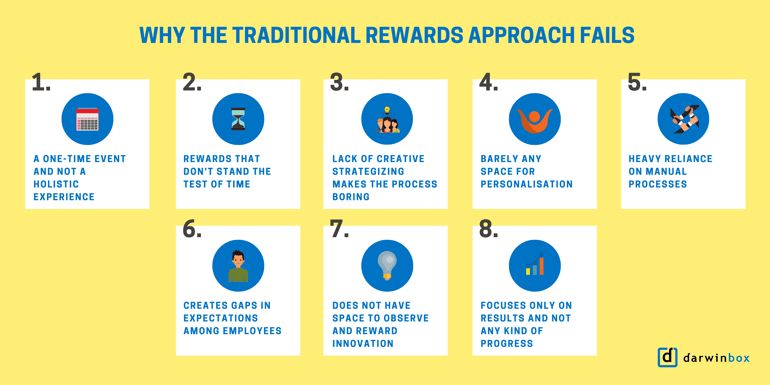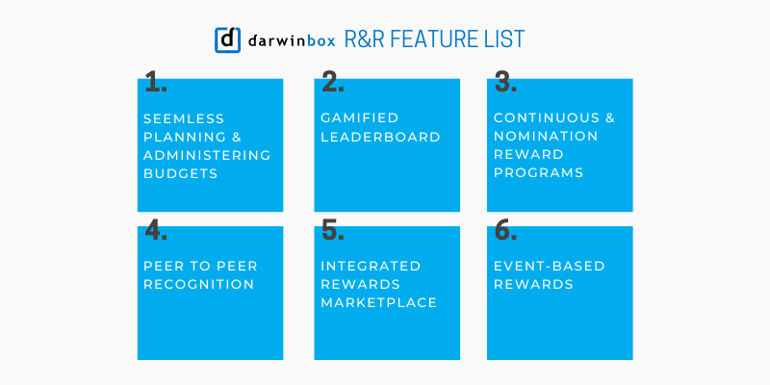
Do you know what keeps me motivated to be my best self at work day in and day out? Appreciation. While words of approval and encouragement might be validating, they’re fleeting beyond a point. You see, if you don’t have the right kind of strategy in place, it isn’t particularly easy to motivate or even retain your best employees.
Yes, attracting talent is important, but what is more important is recognising what they want from their employers. Not just that: In the crossroads of people and change, carrot and stick, smarter rewards and speedy perks, it is critical to creating a rewards package that articulates what you want and need from your employees. And also match what your employee wants/needs with what they deserve.
The best way forward is rather simple. Coming up with a sturdy rewards and recognition strategy! At the end of the day, there’s no better way of letting your employees know that they’re doing well.
Starting from the beginning...
The concept of rewarding someone for a job well done is not new. Be it imagined tales about the blessings of God for their most earnest devotees or even historical ones that explain the importance of olive branches in the Olympics, if you think about it, you’ll realise that they were all initiated in order to appreciate something that exceeded expectations.
Though giving gifts as tokens have always been a rather reliable way to ‘motivate’, what made the approach to rewards and recognition programs more methodical was the industrial revolution.
With Frederick W. Taylor’s extensive studies about factory workers and the factors responsible for their productivity and motivation, something rather grim came out from the shadows: Just the promise of having a job every day wasn’t enough to motivate themselves to be their best selves, or even be moderately efficient.
So in an attempt to make the process better, with the help of his Scientific Management theories, he paved the way for a practice that not just recognised the good work employees were doing but rewarded them too.
Back then, the best kind of workplace rewards were monetary in nature. So naturally, workers were motivated if they were paid more than their peers as a gesture of appreciation.
Traditions guided the way.
But things didn’t quite stay the same.
During the 20th Century, employee reward and recognition programs evolved to actually pay attention to the employees’ needs. From money, recognition awards took a quick leap to give employees trophies, jewellery and vouchers for things a company deemed fit.
Traditional rewards introduced and popularised concepts like:
- Gift vouchers
- Performance bonuses
- ESOPs
- Financial Incentives
- Office vacations
Over the next few years, the evolution of workspaces saw Employee Rewards and Recognition (R&R) strategies introduce employees gifts that were designed to motivate them to work better. But to be honest, with a ‘one size fits all’ approach, these strategies weren’t as robust as organizations hoped they would be.
The death of traditional R&R
With a ‘spray and pray’ approach to R&R, even though organizations were aware that employees needed motivation, they rarely explored or expanded beyond the fundamental concepts of ‘rewarding’ or ‘recognising’.
Stuck in a silo were managers who were only taught to recognise team efforts and reward employees against their performances alone, the process got stuck in a loop where employers failed to look beyond organizational performance. Though that was an easy way out, what it failed to do was drive employee experience and engagement.
Here are some reasons why a traditional approach fails:

With the technological revolution paving the path for drastic changes in workplaces, it isn’t surprising to realise that employee recognition practices are changing as well.
In today's talent-led market, reward strategies are becoming enormously important to help organisations attract, motivate and retain the very best candidates. Rewards can no longer work in silos, but in close congruence with one’s performance and compensation. Here’s why we need smarter rewards to make it a holistic, well-rounded and ongoing experience, rather than a singular article or one-time event. Smarter rewards represent the tool kit organisations need to choose, offer and align a value proposition with an employee - resulting in a satisfied, engaged and productive workforce that creates desired business performance and outcomes.
With the future being more social and flexible, the pace of change is so rapid that traditional methods are well on their way to becoming obsolete.
What’s hot in R&R in 2020?
A successful modern R&R program looks distinctly different from traditional ones. For starters, they have been crafted to include not just personalisation, but socialisation as well as peer feedback. With agility and good communication being key to a program that will not just guarantee employee happiness, but motivate them to grow in unimaginable ways.
The social element: The transparent and social element of such programs allows you to ‘show-off’ your achievements in the form of recognition badges to colleagues, adding to the instant gratification of doing a job really well. It also improves team morale. How? Well, seeing your peers get recognized motivates you to try your best!
Integrations: With integrations playing a key role in R&R strategies, it is clear that such programs can’t operate in silos anymore. By seamlessly integrating it with your company’s learning and performance management systems as well as other HR-Tech modules, a layer of incentive is created. For example, performance management can be integrated with your rewards program to create a layer to incentivize your top performers.
Total Rewards: Total Rewards are a blend of monetary and nonmonetary rewards offered to employees which focus not only on compensation and benefits but also on personal and professional objectives and creating a motivating work culture. Some examples of popular total reward programs are - recognition, work/life balance and career development.
Gamification: Gamification amplifies the effect of an existing experience by applying the motivational mechanisms that make games so engaging. Gamification mechanisms build on top of people’s natural behaviours such as - competition, achievement, engagement and influence. For example, Salesforce’s recognition program - Nitro provides key elements in gamification: points, badges, levels, leader boards, and real-time feedback mechanisms.
R&R programs are no longer defined by employers. Gone are the days when traditional approaches worked as generations wore their medals of honour with pride, motivated by just a promise of prestige. With millennials defining the majority of the systems at workplaces these days, one thing is for sure. A ‘one size fits all’ approach isn’t the right way forward. At the end of the day, rewards are perceived differently by different people and in most cases, a cash bonus doesn’t quite do the trick.
Behaviour change makes the perception of motivation dynamic. And unless your rewards program can match up, it doesn’t quite save the day. It is only by understanding the intrinsic and extrinsic motivators of your team at a macro level that you can craft an adaptive rewards system that is seamlessly in sync with your team’s expectations.
The future is here
While attracting talent is important, at Darwinbox, we realise that recognising what they want from their employers is equally important. And we’re here to let you know that the best way forward is rather simple. Getting your rewards and recognition strategy right! With the right kinds of HR-Tech integrations in place and the right incentives to offer.
Rewards today need to go beyond food coupons and amazon vouchers like getting chosen to attend a coveted event or being picked to attend and participate in a privileged leadership meeting. So it’s essential for businesses to understand how they can personalise rewards to make it desirable, aspirational and relevant for the recipient (because every employee never wants the exact same thing).
Setting up Employee Recognition program is a great way to build a winning culture in an organisation - so if you don’t have one, here's what you need to get started - Download the Rewards and Recognition Starter Kit here.
Appreciation driven by a network-of-humans and an explosive, gamified marketplace of rewards can make rewards contextual, relevant and desirable for each. Today’s cutting edge technology like Darwinbox’s RnR module can help you build a culture of appreciation and recognition among your employees and augment the success of your org’s rewards program.
With a user experience that is engaging and gamified, Darwinbox’s peer-driven and integrated RnR module can boost your employee morale/happiness, increase employee engagement, promote core company values, and encourage certain positive behaviours by virtue of the product design.
Some of our most impressive features include:




Speak Your Mind